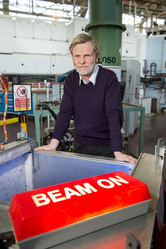Before joining the ISIS Neutron and Muon Source, Stewart had completed a PhD, post-doctoral research and had begun working for BP. But, when they reduced their research facilities, he took the chance to start working in neutron science. He relished the freedom to publish his own research and enjoyed the collaboration with others and the breadth of research topics he was working on, although he has had a particular interest in catalysts and surface species since his days as a post-doctoral researcher.
He started as an instrument scientist on TFXA and, over time, Stewart explains how he “evolved the job". This included being involved in the design and build of TOSCA, which replaced TFXA and began operation in 2000. After a while, Stewart began to feel limited by the experiments he could run on his own instrument and started looking elsewhere in ISIS for different methods to help answer his questions. He found that the direct geometry instruments offered advantages for studying catalysts.

The effect of being an Individual Merit scientist is that it enables longer term planning of research. Rather than focussing on one grant, and then another, he now has a mandate for his research for the next five years. He relishes this opportunity to try new ideas without the pressure of meeting external expectations: “The research emphasis is so often on everything having to succeed, with the aim of one publication per experiment. However, I believe that you learn the most when things fail: science is sometimes uncooperative! Research is a learning curve and I am still learning what the instruments are capable of."
Over the last 25 years, he has seen a steady increase in the efficiency of the instruments, but the real revolution has been in the ability to analyse the data. When he first started, the work he is doing now was completely unimaginable. The philosophy behind the instrumentation has also evolved with more detector tubes and more efficient neutron transport.
In the next five years, he is aiming to study catalysts under realistic time and temperature conditions: operando spectroscopy. Unlike the diffractometers at ISIS, where experimental conditions can replicate the environment faced on application, neutron vibrational spectroscopy is usually done around 10K. Direct geometry may offer an alternative to reach warmer conditions. Operating at very high temperatures is unlikely, but there is lots of chemistry to be done between room temperature and 100 degrees centigrade that is worth investigating.
Although Stewart does not formally lead a group at ISIS, he has extensive collaborations and is currently co-supervising four students from three different universities. In terms of student numbers, he says, “This is proving to be a golden period, which could be due to the fact we've shown the benefits of using neutrons in this field. Although synchrotron usage is common, use of neutrons is less so, despite being able to offer results that cannot be gained using X-rays."
The UK Catalysis Hub, based at the Research Complex, has helped his work a lot: they sponsor some projects but also offer an opportunity to build networks. He hopes the Rosalind Franklin Institute is able to offer the same opportunities to the biologists at RAL as the Hub has for him.
As well as academic collaborations, he has a long term industry collaboration with Evonik Industries and a developing one with Johnson Matthey plc. Although Johnson Matthey has been interested in collaboration for many years, the creating of the UK Catalysis Hub has enabled a personal link between the company and ISIS. This has resulted in a joint fellow being appointed, and two of his students are working with Johnson Matthey.
Stewart's favourite part of his job is doing experiments and analysing the results, and the hardest is “anything that's not that!" Not because it's actually hard, but because it's distracting. He's definitely learnt to multitask!
After 25 years with ISIS he hopes that, in a few more, he'll be able to taper down his working time – but there is a lot of work that needs to be written up first! A long shutdown period coming up for ISIS could prove an opportunity to make a dent but, during the last shutdown, he wrote a book!
“This time I hope to avoid that banana skin and, instead, save that for my retirement project." Watch this space…
60 second sketch
Every member of staff that is profiled is asked to answer ten simple questions that we think will help you to get to know them better.
- Favourite scientist – who would you put on the £50 note?
- Isaac Newton or Albert Einstein.
- What would you be doing if you weren't in this role?
- No idea! I like it so much I couldn't imagine doing anything else.
- Last 'eureka' moment
- I have recently published a paper that turns the thinking around about the state of hydrogen on the surface of platinum during catalysis on its head.
- What book have you just finished reading?
- Bruce Springsteen's autobiography
- Staycation or vacation?
- Dogs or cats?
- Favourite place on Earth
- The creepy answer would be ISIS, but I'm not that desperate… The Grand Canyon was unforgettable, even though it was 40 years ago when I visited. It was a rare occasion where somewhere is better than your expectations.
- One thing you can't live without
- Favourite restaurant
- My best meal ever was at Le Manoir de Quatre Saisons, but for more regular visits, it would be the Brewery Tap.
- If you had a time machine, when would you go?
- It's difficult – you just get tempted to tweak if you go backwards – there are many events that could be done differently.
- I think I'd re-live the Apollo landings: preferably on a better television!
